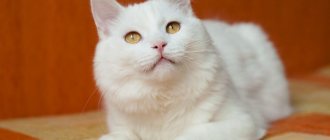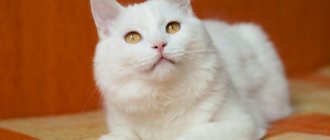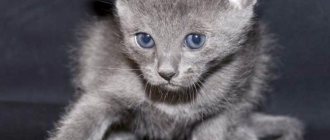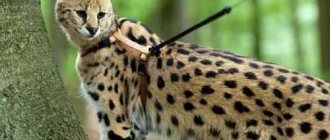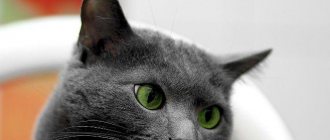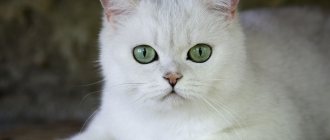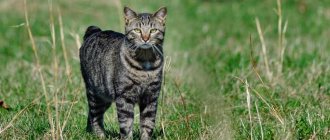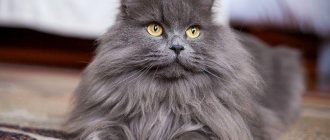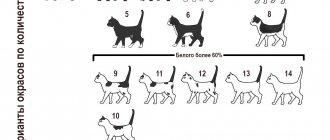Albino animals often attract human attention. Their snow-white fur makes them stand out among their other brethren. This gene is also found among cats. However, not all white cats are albinos, and not all albinos are completely white. Let's look at how albinism manifests itself in cats, what breeds have a genetic predisposition to albinism, and what are the health and behavioral characteristics of albino cats.
Albinism and how it appears
A pigment called melanin is responsible for the color of the fur, skin and iris of animals. It is he who determines the color of the animal, and is also responsible for the variety of coat colors among cats.
There are two types of melanin: Pheomelanin reflects sunlight, causing the fur to appear reddish or reddish. Eumelanin absorbs sunlight and gives the coat its black color.
In the skin, fur and iris, these two types of melanin are contained in different proportions - which gives us a variety of animal colors. The color of an animal is genetically predetermined and in most cases directly depends on the color of the parents and more distant ancestors.
The main feature of albinos is that there is no melanin in their body at all. This leads to the fact that in most cases the fur of such an animal appears completely white, and the eyes appear red. This is due to the fact that there is no pigment in the albino iris, and therefore it is transparent, and we can see the inside of the eyeball and blood vessels.
Albinism is often associated with a genetic mutation. A recessive gene is responsible for the inheritance of this feature. This means that in order to produce albino kittens in a litter, both parents must have this trait. If one of the parents is not albino, most likely all kittens will be born colored.
Albinism is directly related to genetic abnormalities, and therefore such kittens are often born with various pathologies. For example, deaf individuals are often found among albino cats, and some kittens have serious vision problems. Therefore, when buying an all-white kitten, you should immediately check that it reacts to sounds and light, otherwise you may buy an animal with special features.
Albinism can be complete or partial. Full albinos are completely devoid of melanin, and therefore they can only have a white color. Partial albinos may have colored areas of their fur or colored eyes.
There is a so-called W gene. Its presence in the body causes a malfunction in which white begins to dominate the color. Such cats have melanin in their bodies, but due to the presence of the W gene in the body, all its manifestations are completely or partially suppressed.
Animals with complete and partial albinism can be distinguished by their iris. In complete albinos it has a reddish tint, but in partial albinos it can take on different colors. If a white cat has eyes of different colors, then this is a manifestation of the work of the W gene. Moreover, cats with the W gene are often born completely or partially deaf. If a white cat has only one blue eye, then she may be deaf in only one ear. Studies have shown that about 20% of white cats with non-blue eyes are born deaf. About 40% of cats with one blue eye may be deaf. About 70% of cats with both blue eyes are born completely deaf.
We recommend the article: Why can a cat sneeze?
Albino animals are rare in the wild. Due to health problems, they live much shorter lives. The white color does not allow such animals to camouflage effectively, which means they are vulnerable to predators. White predators are much more noticeable, which can lead to difficulties during the hunt. During mating, females show preference for colored males.
However, people consider animals with completely white fur to be very beautiful. Therefore, albinos are specially bred. Among cats, there are entire white lines that are bred as a result of selection of individuals with partial albinism.
Health of cats with heterochromia
Owners of pets with different-colored eyes need to remember the following nuances of furry health:
- If a blue eye suddenly turns red, your cat most likely has a bruise. The veterinarian will diagnose a broken vessel or hematoma, which should only be treated under the supervision of an experienced doctor.
- The color of the eye can change if melanoma grows or another neoplasm appears, a tumor located in the eyeball or fundus. Not every veterinarian is able to make an accurate diagnosis, so if you do not trust one doctor, consider him insufficiently competent, and the treatment does not give visible positive results, do not be afraid to consult another veterinarian.
Albino cat appearance
Not every white cat can be considered a complete albino. It should be remembered that this is a genetic mutation, the presence of which can be determined by the color of the coat, paw pads and tip of the nose. There should be no pigment on any of these areas of the body.
The most important sign of a true albino is the color of the iris. Full albinos have red, pink, or pink-blue eyes. Translucent vessels can be seen through the iris. If the iris is well colored in blue, green and other colors, then such an individual has partial albinism. Among cats, complete albinos are extremely rare. It is believed that one complete albino is born among cats per 10 thousand individuals. At the same time, there are breeds among which albinos are much more common. This is due to their genetic characteristics.
Save and increase
For a hundred years now, the Ankara Zoo has been running a program to breed white Angora cats with different or blue eyes.
At the beginning of the last century, unusual Angora cats found themselves in danger of extinction: the gene for long hair was actively used in the development of new breeds, and there were catastrophically few purebred Angoras left. In 1917, Turkey decided to preserve the breed as a national treasure, and for some time local animals were even prohibited from being exported abroad.
Now other white cats with different-colored eyes are bred in the world - and the British Shorthair breed is not lagging behind in this. For example, a nursery for odd-eyed Britons operates in Rotterdam.
British cat with multi-colored eyes, Riviums cattery
Health Features
In addition to the congenital health problems that often accompany albinism, individuals with this mutation have rather fragile health. They are more prone to colds and are afraid of cold weather and drafts. Areas of the skin that are devoid of pigment and not covered with fur are very vulnerable to the sun. Albinos often suffer from sunburn.
Albinos have a very fragile immune system, and therefore they are more vulnerable to various infections. That is why such cats must be vaccinated without fail. In addition, it is not advisable to keep them with painted animals, which can easily transmit various diseases to their unpainted counterparts.
The albinism gene directly affects the functioning of some internal organs. For this reason, albino kittens are often born deaf and blind. This is due to genetic characteristics, and therefore it is impossible to cure such an animal.
To check that an albino kitten is completely healthy, you need to play with it. The baby should respond to sharp sounds - such as cotton or the rustling of a toy. If the kitten carefully follows the movements of the toy with its eyes, we can conclude that everything is fine with its vision. If a kitten has a hearing or vision problem, you need to understand that such an animal will need special care and increased attention from the owner.
The albinism gene may affect musculoskeletal health. The genetic characteristics of albinos are often associated with impaired formation of cartilage tissue, which is why the animal may suffer from problems with joints, claws and teeth. Some diseases can develop with age, so the health of an albino cat must be monitored very closely and periodically taken to the veterinarian for examinations.
Types of “oddity of eyes”
The term “heterochromia” comes from Greek and means “different color” or “different color.” Heterochromia can be partial, when there is an area on the iris of one or both eyes that is colored a different color, such eyes are called dichroic.
In cats, sectoral or ring partial heterochromia is distinguished: in the first case, only part (sector) of the iris is painted a different color, and in the second, the outer edge of the iris is framed by a ring of a different color.
If heterochromia is complete, then one cat's eye may be green, yellow, orange or copper in color, while the other will certainly be blue. In English, differently colored eyes are called odd eyes.
Albino cat personality
The character of an animal rarely depends on color. So albino cats may be no different from their colored counterparts. Although it is worth noting here that the albinism gene can affect the health of the animal, but this point is already associated with changes in behavior.
Albino cats may be highly sensitive to sounds and bright lights. They are more vulnerable and therefore need attention and care. Such cats can follow their owner everywhere and get nervous if he is not nearby. In unusual situations (when moving, new animals and small children appearing in the family), albino cats can experience extreme stress.
We recommend the article: Why does my cat's belly sag?
Albinos can be more cowardly. If guests come to the house, they prefer to hide. Other cats may dominate them. Such animals are very anxious and modest. At the same time, they can be quite intrusive towards their owner, as they need increased attention.
How do eyes get their color?
Eye pigment is produced by pigment-producing cells called melanocytes, which are present in the iris. The exact color and its intensity will depend on the number and activity of melanocytes in the iris. If there are no melanocytes, the eye will be blue. A low content of melanocytes results in a green color, and a high content of melanocytes creates an orange (sand, brown) color. If melanocytes are less active, the intensity of a given color will be lighter and vice versa. The activity of melanocytes is determined genetically. Several genes at different locations on the chromosomes control the pigmentation of the iris.
Maintenance and care
Albino cats are very vulnerable to various diseases, and they also have fragile health. That is why such animals need more careful care. When purchasing an albino pet, the owner must be prepared for the fact that such a cat will have to pay much more attention than its colored counterparts.
Due to their fragile health, albino cats should only be kept indoors. Walking on the street is contraindicated for them. On the one hand, they are vulnerable to various infections, as well as drafts. On the other hand, sensitive skin gets sunburned easily. In addition, walks can be a source of stress for rather timid albinos.
It is advisable for the cat to have its own place at home. You can buy a special house in which your pet can hide and feel protected. Albinos really need the attention of their owner. If the owner is at work all day, the animal may become very bored and even stressed. This is especially true for cats with special needs - deaf and blind, who need much more attention.
Anatomy of a cat's eyes
A cat's eyes are large compared to the size of its head. As described in the MSD Veterinary Manual, the bony cavity or socket that contains the eyeball is called the orbit. The eye socket is a structure made up of several bones. The orbit also contains muscles, nerves, blood vessels, and structures that produce and drain tears.
© shutterstock
The white of the eye is called the sclera, which is the tough outer layer covered by the conjunctiva (a thin membrane). This covers the inside of the eyelids. In front of the eye is the cornea, a transparent dome that protects the eye and allows light to pass through.
The iris is the round colored area of the eye behind which the lens is located. The retina lines the back of the eye and becomes sensitive to light. This is what turns light rays into nerve impulses. The retina sends rays to the brain, which converts them into an image.
Light enters through the pupils, which quickly respond to changes in light. In the sun, your eyes will become small. In the dark they will expand so the cat can see.
Nutrition
It is not advisable to feed albino cats natural food. They have much more sensitive digestion, and therefore some foods may be poorly digested and cause a negative reaction. Finding the optimal diet for such animals is much more difficult. In addition, some foods can cause the animal's fur to change color - a snow-white cat can easily turn yellow.
Dry and canned food is good for albinos. It is advisable to buy food labeled “for sensitive digestion.” Preference should be given to premium and super-premium class. Economy class food not only will not bring any benefit, but can, on the contrary, lead to digestive disorders.
Interesting facts about the breed
Some interesting facts to better understand these magnificent animals:
- most Angoras are not afraid of water; on the contrary, they love to swim;
- The appearance of angora dogs in Russia occurred at the end of the 18th century; several animals were presented to Empress Catherine II, at which time fame began to spread about the extraordinary fur of these animals. They were carded, and gloves and stockings were knitted from the wool.
- Despite their dislike of being held, Angora cats are dependent on human communication and have a hard time with separation. No matter what color the Angora cat is, it is always the standard of elegance and grace, an excellent companion and home decoration.
Hygiene
Albinos, like other cats, usually manage their own hygiene on their own. However, dust and dirt are much more noticeable on snow-white wool than on dyed wool. Not all albinos cope with maintaining their fur in proper form. In this case, owner intervention is required. It is not advisable to bathe cats frequently. Frequent exposure to water and detergents can cause the skin to dry out and become more prone to dermatitis. Dust from wool can be removed with a damp cloth.
Once every couple of months, the animal can be completely bathed. During the procedure, special shampoos should be used. Human cats are not suitable. They may have odors that are irritating to the animal. In addition, they contain components that can lead to irritation on the pet’s skin. It is worth noting that there are special shampoos for albino cats that help whiten their fur. After bathing, your pet should be protected from drafts. You can't let him go outside with wet fur.
You should also monitor the condition of the eyes, ears, fangs and claws. You can wipe your eyes with a cotton pad moistened with clean boiled water. Ears can be cleaned with cotton swabs, and claws can be cut with a nail clipper. Veterinarians also advise periodically brushing your pets' teeth. To do this, you need to use a special toothpaste and brush. A cat should be taught to brush its teeth from childhood.
We recommend the article: Why the cat’s eye is cloudy: causes, treatment methods
What happens if you have a white cat at home?
Odd-eyed cats, as a rule, are highly valued, and if you plan to acquire such an animal, be prepared to shell out a large sum. It would also be useful to remind you that the eye color of kittens is established only by 5–6 months. If a kitten is born with heterochromia, then the different eye colors become noticeable at the age of 3–4 months. Therefore, when buying a kitten in an unreliable place and without documents, the seller’s assurances that the baby’s eyes will later become different colors may well turn out to be a deception - you will not be able to check this in advance.
What is the name of the breed of cats with different eyes and a snow-white coat? Such photos can very often be found on the Internet - most of them show off Kao Mani, Turkish Angora, Persians and some other breeds, including mestizos. Let's take a closer look at each.
Khao mani
Khao Mani cats, White Gem Cattery
The Khao Mani is a native breed of Thailand. This flexible, completely white cat with an athletic build was very popular in high society and was known as a favorite of royalty. Despite a history dating back several hundred years, the breed was registered only in 2009, and the CFA standard appeared on the official website of the Cat Fanciers Association only in 2018.
To this day, the breed is considered very rare; there are no Kao Mani nurseries in Russia yet. According to the standard, a Khao Mani cat can only be white with eyes of a bright pure color of any shade - from blue to copper, including multi-colored eyes.
By entering “Kao Mani” into the search bar, you can see a large number of photographs of the odd-eyed Kao Mani, although such cats are not very often born within the breed.
Turkish Angora
Despite the fact that a large number of different colors are recognized as the Angora standard, it is the white odd-eyed cat of the Turkish Angora breed that is considered the national treasure of Turkey - to this day, a joint program of the Turkish government and the Ankara Zoo for breeding odd-eyed white Angoras operates in this country.
The Turkish Angora is incredibly beautiful, inquisitive and playful. The semi-long snow-white coat of the Angora does not require too much grooming. Angoras with different eyes will have one eye blue and the other green, golden-green or amber.
Turkish van
Turkish Van cat, photo by Lyudmila Pankova (Tessa.lv)
This is an indigenous semi-long-haired cat breed that descends from animals that lived in the area near the Turkish Lake Van. These cats have a very characteristic unique color, which is called “Van”. At least 80% of the surface of the cat’s body should be white, and only the tail should be red-chestnut with the usual rings, and spots of the same color on the face and back near the shoulder.
The classic color of Vans is red, but black, blue, tortoiseshell and cream are also acceptable. A cat with different eyes of the Van breed is not so rare; in this case, a blue eye will be complemented by an amber one.
Oriental
Orientals are unlike any other breed, and looking at them, it is easy to wonder if they are even cats. An elongated, muscular body with long slender limbs, huge ears, a long muzzle and elongated eyes, as if squinting - this is how you can describe a typical representative of this breed.
Add to the extravagant appearance a friendly, playful character and complete intolerance of loneliness, and you will get a great companion cat.
In cats with different colored eyes of the Oriental breed, one eye will be blue and the other bright green, because this is the color that is most characteristic of it, although among other breeds the variation of blue and yellow or blue and orange/copper is more common.
The Persian cat, known since ancient times, and its close relative, the exotic cat, have much in common in their breed standards, with the possible exception of the texture and length of the coat.
Persian cat, CH PL Bagira Vivaldi Legacy
The long, thin and very fluffy coat of Persians requires very careful and competent care, while exotics sport a short, thick and plush to the touch coat. That is why exotics are called Persians for the lazy.
Exotic breed cat, Toxicate cattery
There are also differences in character - Persians are considered relatively calm and balanced creatures, although with a certain temper. And exotics are exceptionally gentle and friendly with their owner - their charming appearance fully corresponds to their flexible character.
As for odd-eyed white Persians and exotics, the standard is to pair a blue eye with an eye of a deep dark orange or copper shade.
Perhaps both of these breeds are the most popular both in Russia and throughout the world, due to their beautiful appearance, ease of care and calm, independent character.
British breed cat
And although the most common color among the British and Scots is blue, the snow-white representatives of these breeds look especially impressive. It is these cats that have eyes of different colors - blue in combination with gold or the color of dark copper.
Scottish cat, Timosha cattery
Rex cat breeds with curly fur are called. These include the Cornish Rex, Devon Rex, Selkirk Rex, Ural Rex and La Permian. All these breeds have a huge variety of colors and eye colors. Among animals with a solid white color, there are individuals with multi-colored eyes, when one eye is blue and the other is yellow, gold or green of different shades.
Devon Rex cat, photo Irene McCullagh
There is an opinion that people are divided into two types: some categorically do not perceive sphinxes or treat them with bewilderment, while others cannot live without hairless cats and do not even want to think about any other “normal” representatives of the feline family. Only one thing is absolutely clear: the Sphinx will not leave anyone indifferent. The shocking appearance is complemented by a peaceful character, and sphinxes are perfectly trainable.
The Sphynx standards recognize all colors, including white, and the large lemon-shaped eyes can also be of any color. Sometimes white sphinxes have different colored eyes - blue and yellow or green.
What canned food tastes best for cats?
RESEARCH ATTENTION! You and your cat can take part in it! If you live in Moscow or the Moscow region and are ready to regularly observe how and how much your cat eats, and also remember to write it all down, you will receive FREE SET OF WET FOOD.
Project for 3–4 months. Organizer - Petkorm LLC.
Want to participate? Call!
There is no single, specially bred breed of white cats with different eyes. Divergence of eyes occurs in British, Devon Rex, Maine Coon, Scottish and others. However, there are lucky people for whom heterochromia is most typical.
The breed is named after the Van district in Turkey. Very active and cheerful cats, quickly making contact with people and becoming tame. Their color can be not only pure white, but also tortoiseshell - have inclusions of golden, brown, gray, black. The eyes are usually different - yellow-blue. Animal fur is so soft and pleasant to the touch that the desire to stroke it arises in absolutely everyone who touches it.
Cats are extremely sociable and literally follow on the heels of their owner. Looking languidly into their eyes, they do not miss any opportunity to jump on their hands or knees. They love heights and easily climb the “tops” of refrigerators, cabinets and mezzanines. They also do not refuse to take water treatments, enjoying swimming in the bathtubs or exploring street puddles. They respond quite well to training, quickly learning commands such as “give paw”, “sit”, “fetch”, etc.
We invite you to read: Changes in color in cats: causes and correction. Manifestations of hyperpigmentation reaction. Other reasons for color changes
Another breed of white cats with different eyes. Named after the Byzantine city of Angora, from where it was later brought to Europe. With a rather elegant physique and low weight (3-4 kg), cats are distinguished by well-developed muscles and a stable immune system. The fur is long, soft and fluffy, but has virtually no undercoat.
In addition to the classic color, the beautiful Turkish dog can have cream, marbled and even black coat, but white is still considered the standard. The vulnerable point of the Angora, like other cats with different eyes, is the tendency to deafness. However, this defect is perfectly compensated by its devotion to one owner, as well as its peacefulness and tolerant attitude towards other pets (dogs, birds, rodents). They are quite picky about food, so the diet must be selected very carefully.
Khao Mani
The homeland of this breed of cats with different eyes is Thailand. Translated, Khao Mani sounds like “diamond eye” or “white pearl”. Initially, cats were kept only at the royal court, and only many centuries later did they become available to ordinary people. Although the price for representatives of the cat world still remains very high, so not everyone can afford to keep them at home.
The animals have smooth short hair, a small body size and a slightly elongated muzzle. By temperament they are sociable, friendly and affectionate. They are unpretentious in maintenance and extremely clean, so they are easy to care for. Pathologically they cannot be alone, preferring to always remain in the center of attention. They are believed to bring peace and good luck to the home.
And the last thing I would like to note that white cats have in common is their ability to be a true friend and partner for life.
If the eye becomes not even blue, but for example a reddish color, then this is most likely a bruise. In this case, you need to urgently contact a good veterinarian. This may turn out to be a simple hematoma or a burst vessel. But the diagnosis is not always so easy to make. For example, a change in eye color may indicate the growth of melanoma or some other foreign formation in the fundus or apple.
Albino cat breeds
Albinos can appear among different breeds. And yet there are breeds among which such individuals appear much more often. Some breeds even appeared as a result of breeding individuals with albinism. It is not easy to get snow-white individuals, because a recessive gene is responsible for this color. In addition, during the selection process there is a high number of cullings. Since the albinism gene often leads to deafness, animals with hearing impairment cannot subsequently participate in breeding.
Breeders rarely use individuals with complete albinism for breeding, as they have a number of health problems, which can only intensify during the selection process. But the gene for partial albinism is found in many breeds. Due to selection, the following breeds can boast a completely white color: Turkish Angora, Foreign White, Kao Mani. There are also breeds among which individuals with incomplete albinism are much more common - these are the Siamese, Burmese, Thai, Balinese, Tonkinese and Himalayan.
Khao-mani
The breed comes from Thailand. It is very rare and considered expensive. These are snow-white cats with short hair. Their main feature for which the breed is valued is their multi-colored eyes. There are individuals with the same eye color, but cats with heterochrony are valued much more. In Thailand they are believed to bring good luck.
Kittens are often born with a small dark spot on their head that fades over time. With age, the animal becomes completely white. Most individuals have hearing problems. They are often deaf in the ear on the side of the blue eye.
Foreign white
This breed is related to Siamese cats. Breeder Patricia Turner from the UK set herself the goal of breeding a cat with the body of a Siamese and snow-white fur. In addition, she set herself the goal of minimizing the appearance of deaf individuals among the representatives of the breed. As a result of long work on selection, the goal was achieved.
Foreign Whites are very similar in character and characteristics to Siamese cats. They are smart and can learn commands. These cats are very talkative. Deaf individuals are practically never found.
Other breeds that have heterochromia
Animals of different colors can have multi-colored eyes - for example, tortoiseshell with white spots. But the determining factor in the manifestation of discord is the presence of the “white gene”.
Breeds in which this feature is often found:
- Oriental. White cats of this breed are sophisticated and graceful. The most common combination of eye colors is blue and emerald.
- Scottish and British women sometimes bring snow-white kittens with different eyes. Usually blue is paired with copper color.
- Exotic and Persian cats are rarely snow-white. Usually the color contains multi-colored spots. Heterochromic kittens have blue and amber eyes.
- Sphinxes. Hairless cats can also be carriers of the “white gene”.
- Rex. This breed is distinguished by short wavy fur, large ears and huge eyes. The companion color is usually green or amber.
A British man with different eye colors
Heterochromia manifests itself even in outbred animals. Unfortunately, there have been no studies on this issue, so there are no statistical data.
Character and psychology
The Turkish Angora is distinguished not only by its attractive appearance, but also by its social character.
The intelligent look of the Angora is not only an external characteristic. Turkish cats are really smart. With due diligence, it is possible to teach several commands, for example, to bring slippers, open and close the door.
The similarity with dogs is also manifested in the devotion of pets. The cat's love of love is enough for all family members. But the greatest affection will arise only for one person. Angora will be faithful to him until the end of her days. If separated for a long time, your furry friend may become withdrawn and lose his playful mood. The sensitivity of the Turkish woman is so strong that it helps to assess the state of mind of the owner. Adapt to it.
The Angora breed does not tend to sit for long periods of time in its hands. But the inherent desire is to be the center of attention. Angora is distinguished by non-standard cat sounds. No loud meows. The conversation consists of specific purring-uterine sounds. The cat will accompany them with almost all of its actions.
The sociable nature is evident even towards strangers. Angora welcomes you with Turkish hospitality
Every person will be treated with cat's attention
A calm mood easily gives way to a playful, robber state. Angoras easily make a mess. Of course, when you’re rushing around the apartment at the speed of light, it’s hard to notice what’s under your feet. More precisely under the paws. The breed definitely has a lot of energy. And love for tricks too. But for children, Turkish cats make excellent partners. Playing games together brings pleasure to both.
Good relationships also develop with other pets. But on condition that they recognize the Angora as the undisputed leader.
Hunting instincts manifest themselves in the desire to hide their treasures. The most unpredictable places are selected for this. Ambushing is also a favorite activity of the domestic predator.
Modern sphinxes
Now it is quite difficult to say whether the Sphynx breed is a descendant of ancient cats or the mutation has repeated itself again. In nineteen sixty-six in Ontario (Canada), the most ordinary domestic cat gave birth to an extraordinary furless kitten. It was this year that went down in history as the year of the appearance of modern sphinxes. Although this is not entirely true. The fact is that, despite quite serious breeding work with hairless cats, by the mid-seventies the breed had practically disappeared. And only the repeated discovery of three hairless kittens in the vicinity of Ontario gave a “second life” to the breed.
The kittens ended up with compassionate people who tried unsuccessfully to cure them of lichen. Then the kittens were handed over to specialists. This is where the breeding of sphinxes began.
